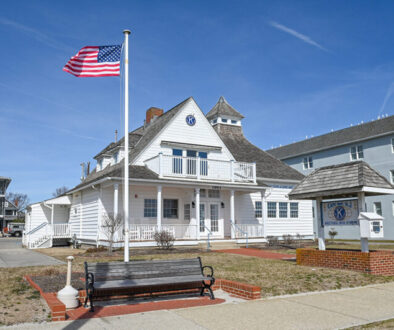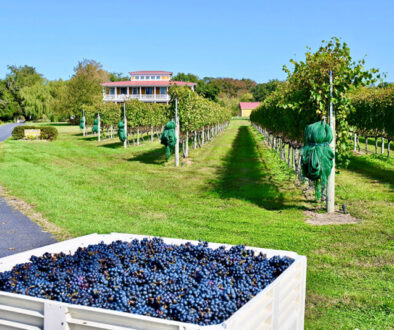The Little-Known Story of Victorian Towers
The years following World War II were not good to Cape May. War industries and military bases were dismantled, resulting in a decrease in the number of year-round jobs. As the 1960s dawned, many stores had gone out of business, hard-to-maintain summer Victorian cottages were in disrepair and no longer appealing to tourists, and children who had been raised in Cape May abandoned the city to find employment elsewhere. Many residents earned income by providing services and goods for cottager families who spent eight to ten weeks a year here in summer months, but now even those families were moving on to more modern resorts. And then the now-famous 1962 Nor’easter hit the coast, causing considerable damage to New Jersey coastal towns. These factors—and more—altered the city’s demographics and forced town leaders to act, which they did by acquiring federal monies for projects that recreated large portions of the town.


Victorian Towers was one of those new construction projects made possible by massive numbers of demolitions, creating available land for new buildings and streets within a 77-acre area designated as Victorian Village.
In 2023 Victorian Towers, the final project in this Victorian Village, celebrated its Golden Anniversary. Few people remember the five years of controversy around its construction or the details of urban renewal and other federally funded programs that consumed the city from 1962 until 1973.
Some projects were conducted under urban renewal, others with federal public housing dollars, but the Victorian Towers project was unique. Mortgage funds, provided by the New Jersey Housing and Finance Agency (HFA), financed construction of senior citizen apartments on a huge parcel of city-owned land assembled via urban renewal demolitions. More than 12 buildings, some of Victorian architecture, were demolished, including the Glenwood Annex and the Hotel Sylvania on the east side of Ocean Street as well as the entire block of 12 stores on the south side of Washington Street. These businesses faced the north side of Washington Street opposite a block where passenger and freight train stations were once located between Washington and Lafayette Streets. After demolition in 1966, the empty land allowed Ocean Street to be extended to Lafayette Street and created the Victorian Village Plaza Shopping Center, today’s location of the Acme and smaller stores.
The high-rise apartment house project was reimagined, redesigned, and reincarnated from 1968 when it was first proposed until 1972 when finally approved and constructed for its 1973 opening. The September 9, 1968, issue of the Star and Wave reported the first iteration of plans from a Lakewood developer, the American Redevelopment Corporation, to build “69 apartments over top a covered shopping mall which would be flanked by spaces for a maximum of 20 retail stores on the ground level” with a projected price tag of $800,000. Developer Jay Kaplan was working with the city on a second 60-apartment unit building on land near the water tower on Columbia Avenue. This project was a little more complicated in that the needed land was made up of three lots, only one of which was owned by the city, the others by private individuals. The land on which both apartment complexes would be built was to be advertised for bid, the Columbia Avenue property in October and the Washington Street parcel in November of that year.
Although city and urban renewal officials wanted to quickly adopt the Jay Kaplan plans, neither of these projects were built. The auction was held for the Columbia Street lot. Although Kaplan and the city officials believed that he would obtain the lot for about $4100, Carl McIntire, owner of the Christian Admiral Hotel and other properties in Cape May, bid against Kaplan before dropping out at $12,449, causing Kaplan to pay three times what he expected.
A stipulation of the purchase was to obtain a mortgage to cover construction costs. In the meantime, the city changed the policies for selling vacant lots from auction to purchase. Properties were to be appraised and sold for appraised values to a city-selected company. Developers would submit detailed design and construction plans for review by the city for compliance with Victorian Village urban renewal building requirements. By July 1969, Kaplan and his American Redevelopment Corporation had dropped out of both projects. In an effort to put the Washington Street land to good use, a Star and Wave story reported, the city “was making the land available as an open-air shopping area.” City officials envisioned the land as “best suited for vegetable stands, flea markets, and non-profit organizational activities.”


The idea to build an apartment building on the Washington Street parcel was still pursued by City officials, but news of new plans did not surface until almost a year later, in November 1970, when a description was bundled in a Star and Wave story about all the new construction taking place. The newly designed six-story apartment house was to have a first-floor restaurant, open to the public, and 223 units made up of one-bedroom and efficiencies occupied only by senior citizens with low to moderate incomes. The senior housing, financed with mortgage funds from the New Jersey HFA and owned by the Catholic Diocese of Camden, was estimated to cost $3,000,000, representing a huge jump in purpose, use, size, and cost when compared with the earlier American Redevelopment Corporation proposal.
Today, people would say that the project did not have a lot of fans among people who lived in or were regular visitors to Cape May. However, the mayor and city government were huge fans and wanted this project to move forward. Every week during the end of 1970 and through all of 1971, local newspapers reported dissension among townspeople and city government in what retrospectively seems to be a firestorm of public opinion concerning the building, including the need for it, its appropriateness for the proposed location in the center of town, its size, design, proposed materials, and any number of other perspectives. Having opinions and expressing them is a long-time attribute of Cape May citizens.
If widely varying opinions about the building were not enough “publicity,” the project got caught up in and often became the centerpiece of other potentially more significant concerns, one of which centered on the city administration’s plans for recreating Cape May. The number of historic buildings being demolished within the Victorian Village urban renewal district and the future of the Physick Estate were two concerns. City fathers responded in December 1970 by disbanding the Historic District Commission, so there was no government body to review proposed demolitions or new construction designs and, theoretically, anything could happen.
In a rare coincidence, although not publicly announced until the end of January 1971, Cape May was named to the National Register of Historic Places, a distinction city government officials neither wanted nor understood. The entire city limits plus part of West Cape May were part of the district, estimated to include more than 600 structures with architectural merit. David Poinsette, supervisor of the state’s Historic Sites division, explained the designation at a City Council meeting covered in a lengthy article by the Starand Wave, January 28, 1971.
This and other explanations did little to alter the city government’s position that the designation would jeopardize important modernization projects—including the proposed Washington Street senior citizen apartments. Mayor Frank Gauvry and city council undertook an aggressive effort to keep the possible negative influences of the historic recognition in the public eye through weekly stories all the way through the fall of 1971. Into the spring months, the city’s position became even more entrenched and aggressive. The Atlantic City Press quoted Mayor Gauvry in a May 5th article saying, “Legal action will be taken against those who had this City placed on the National Register of Historic Places… unless construction of a six-story apartment building is permitted here.” Gauvry went on to confirm rumors that the building design had been turned down by the Historic Sites Council. City officials had walked out of an April meeting. Gauvry described the project as “bogged down.” The battle lines seemed to have been drawn as Gauvry continued to endorse a six-story building as “necessary for the builder to get a return on his money,” pointing out that “the property was valuable because of its location.” News of the impasse, described by Gauvry as “three stories apart,” because of what the historians wanted, expanded to become ongoing news in east coast newspapers.

At this point, clearly the city administration was more about winning and less about negotiating. In a second, retaliatory move, the administration refused to enter into an already-prepared lease agreement with the Mid-Atlantic Center for the Arts (MAC) allowing the organization to use the Physick Estate. At the time, the mayor explained this action by saying that “under the circumstances and in view of the many ramifications of the Historical designation…, we are pending the entrance into any formal agreement that could have any adverse effects at a later date.” Later, when grant funding had been obtained for the city to purchase the Physick Estate, the city refused to accept the funds. Too many demolitions of Victorian structures and their replacement with bland modern or Victorian-styled buildings, elimination of the Historic District Commission, negative reactions to the historic designation, and the final blow of grandstanding around the Physick Estate resulted in formation of a citizen group whose goal was to push the mayor and council out of office. In a few short months, the drama-filled administration was replaced by one that not only supported, but celebrated, the city’s Victorian architecture—and accepted the previously rejected grant, thereby saving the Physick Estate.
During “urban renewal times,” everything in Cape May was labeled Victorian whether old, new, or just the name of something. In line with labeling bars, restaurants, shopping centers, notable mansions, and other properties with Victorian in the title, by the summer of 1971, the senior housing was also labeled Victorian—as Victorian Towers. It was as if the label would make the project more palatable. But many people remained highly critical. Issue after issue of Star and Wave letters to the editor—1970s Cape May’s equivalent to social media—were a breeding ground, spreading any number of what must have seemed like fake news reports requiring continual explanations by City administration. In March, as the furor about the historic designation’s potential negative impact on the senior housing began dying down, Mayor Gauvry addressed what he called a “great misconception” about the Catholic Church and its role in the senior housing complex, saying, “Let me make it clear. This is not being built with Roman Catholic Diocese funds…It is not built for Roman Catholics. It will not be run by the Roman Catholic Church.” He went on to say that the apartments “happen to be sponsored by the Diocese of Camden because they are in their own building program.”
Having tried unsuccessfully since 1968 to obtain a developer to build a large apartment complex on this Washington Street lot, city government and urban renewal people must have felt finally successful in putting together a deal with high potential to actually get it built. The focus on senior citizens, not part of the original plan, emerged from the August 1969 Hearings of the Special Committee on Aging of the United States Senate, 91st Congress, where the director of Cape May’s urban renewal program, David Heacock, provided testimony about the aging population in Cape May. The 1960 Census recorded older people living in the city as 12.4% of the population, which increased to 16.7% in 1970, demonstrating a need for senior citizen housing. Heacock testified that 50 out of the 280 homes in the Victorian Village urban renewal area were owned by senior citizens and that as many as 5,000 apartment units had been proposed as possible senior citizen living accommodations although few had been built. He went on to say that a “major problem is locating the buildings near convenient shopping areas within easy reach of senior citizens.”
The Victorian Towers project certainly addressed these issues, including putting the housing near shopping, restaurants, and other services and stores likely to be used by elderly people. Creating housing for senior citizens who were interested in downsizing or simply retiring to Cape May was a city administration goal, not just to be responsive to the needs of current Cape May residents but to attract new people to the city to address the equally large issue of a declining year-around population. Even with these good intentions, with a partner organization eligible for funding for senior citizen housing, and a developer, other issues had to be addressed before the project could move forward.

By 1960 when this photo of the Ocean and Washington Street corner was taken, the Reading Railroad Station was leveled. On the right the Acme Market building and the adjacent structures were demolished to make room for what became the Victorian Towers.
Long before all the dissension had emerged, in September of 1970, the city had requested amendments to the urban renewal project regarding the mall and this Washington Street land parcel. Amendments for the parcel included a change of the designation from commercial to residential, and amendments to the building design and height to accommodate the now six-story apartment project. HUD approved the amendments related to the mall but not until the end of May 1971 and, only after the state Historic Site Committee had approved the plan, was an agreement reached regarding the parcel. Again, the Star and Wave published an extensive article to inform the public about the agreement requirements which related to size: lowering the number of stories and height of the building, reducing the units from 220 to 203, adding the Mansard roof, and resubmitting new design plans to be reviewed for approval by the New Jersey Housing and Finance Administration. None of these requirements addressed the zoning issue, but the city ultimately amended its zoning code in October to zone the parcel as residential.
But even that was not the end of the story. A group of citizens, primarily people living on Hughes Street, brought a suit in November against the city for spot zoning the property, and were successful in obtaining further changes to the design and landscaping between the back of the property and the rear of the impacted Hughes Street properties.
By this time, Cape May residents were realizing that despite the not-so-transparent discussions of the project, the building would, in fact, be owned by the Catholic Diocese and, therefore, could be excluded from tax payments. The city had floated a figure of a $70,000 per year payment in lieu of taxes which was based on a potential $2,000,000 property valuation. The late Gus Andy prepared a report presented to the City Council in October illustrating how the project would cost taxpayers $130,000 a year in lost tax revenue. He also discussed the illegality of spot zoning the project as residential, the lack of sufficient parking, and the impropriety of placing a building of that size next to surrounding Hughes Street and other Washington Street properties. He suggested a smaller building with more parking and a buffer between the building and Hughes Street. Jack Needles, then City Manager, said that public officials were happy with this arrangement and satisfied that tax ratables were not being lost. Increasing ratables was a major goal of Gauvry’s administration, who informed the public again and again that their actions, new development, and other projects were not costing citizens any money. In all probability, this may have been the best package, maybe the only package City officials were able to put together to develop this land in the way envisioned.
By the end of 1971, most issues had been resolved or at least addressed, but not necessarily in ways that pleased everyone. Following a two-and-a-half hour hearing held in early November at City Council, once again the Star and Wave summarized citizen remarks. Those in favor of the project cited the need for senior citizen housing, the benefits to downtown merchants, and while the project might not provide maximal ratables, it would provide more revenue than the city had been able to generate by holding vacant urban renewal land. All approvals and plans for Victorian Towers were completed by early 1972, construction was begun, and eligible seniors moved into their apartments in 1973.
Few modifications were made to either the apartments or the outside of the building until 2018, when extensive remodeling was undertaken to the inside and particularly notably, to the outside of the building. Since its earliest iterations, the building design mimicked the Victorian look through features like the mansard roof, while “ignoring” the fact that a multi-storied brick building in Cape May during the Victorian heyday would have been extremely unusual. Only Congress Hall, rebuilt in brick after the 1878 fire, comes close.
However controversial, this project has become not so important as the neighborhood around it has changed dramatically since Victorian Towers was built, and the building now unobtrusively fits into what is pretty much a commercial or business area. Seniors, who today might not even view themselves as old enough to be called seniors, continue to benefit from rental rates allowing them to live in Cape May without being priced out of housing. Maybe 50 years ago when the mayor and city council used those urban renewal opportunities for Victorian Towers, they were onto something, intended or not, that has fulfilled its goal of providing housing for the many senior citizens who have made their homes in this building.
But Gus Andy may have been clairvoyant in 1971 when he predicted that parking was inadequate.



